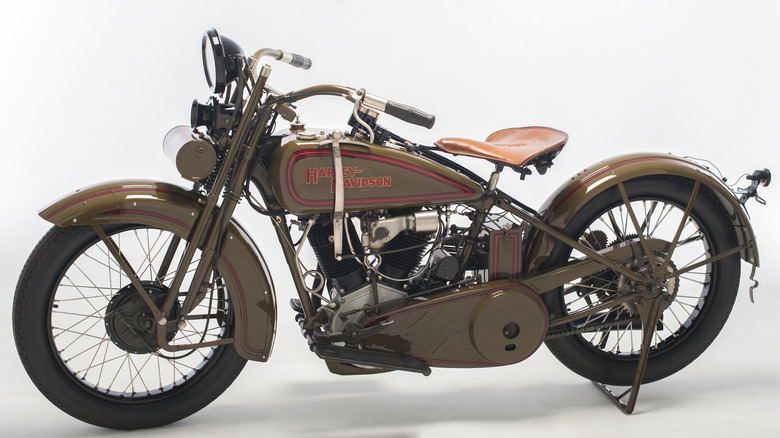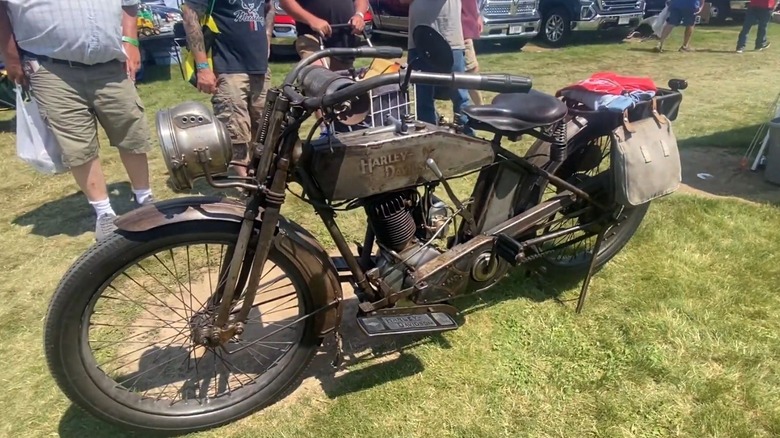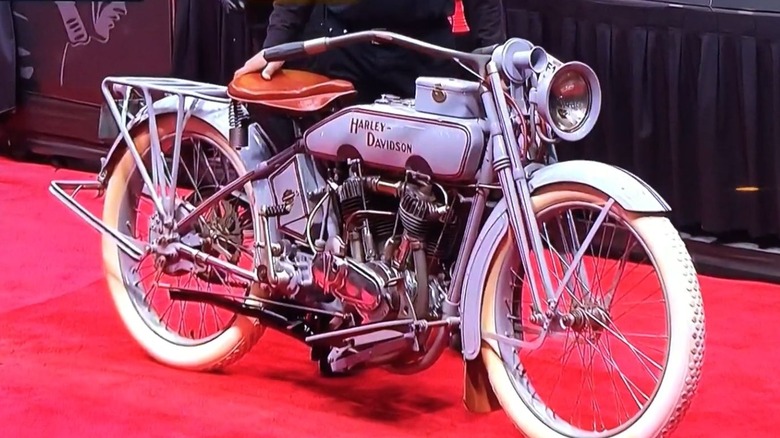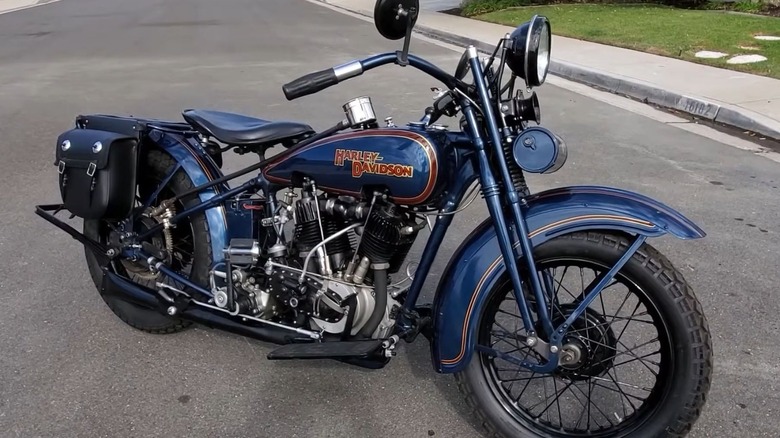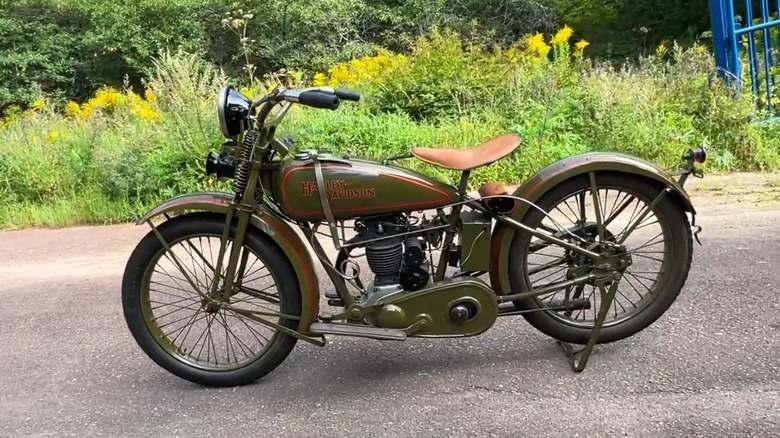4 Underappreciated Classic Motorcycles From The Early Days Of Harley-Davidson
When discussing motorcycle companies that have shaped today's U.S. bike scene, it is difficult not to mention Harley-Davidson, the motorcycle company that has more than laid the foundation for what cruisers and tourers should be. The company has existed for decades, with its origins tracing back to 1903. Harley-Davidson was founded in Milwaukee, Wisconsin, by William S. Harley and Arthur Davidson–two visionaries who started with nothing but a dream. Only two years later, the company completed its first motorcycle, the Model 1, which was essentially a bicycle with an engine in its middle. Harley and Davidson continued to push forward, and by World War I, their company had already become one of the leading motorcycle suppliers in the U.S., even providing bikes for the war effort alongside Indian Motorcycles.
Over the last century, Harley-Davidson has continually released motorcycles that turn heads wherever they go. The company boasts an impressive lineup, to say the least, with options for nearly everyone interested in getting behind a pair of handlebars and hitting the tarmac. Whether you are looking for some of the best-sounding motorcycles available or bikes that are dirt cheap to maintain, the manufacturer has you covered. However, while the company enjoys popularity today, many of its most celebrated bikes are from the 1950s and onwards, which is disheartening considering the remarkable motorcycles produced in its early years. From the 1915 Harley-Davidson 11-F to the 1927 BA, here are four of the company's most underrated vintage bikes that helped shape Harley-Davidson into what it is today.
A three-speed touring machine that was ahead of its time
Harley-Davidson was still a budding company when it launched the 11-F motorcycle. The company had spent most of its first decade establishing and solidifying its position as a motorcycle manufacturer, with tasks such as getting incorporated in 1907 and introducing its first V-twin engine two years later. By 1913, it had already built a six-story brick factory to meet growing demands. In 1915, Harley introduced the 11-F, a three-speed sliding gear transmission, 61 cubic inch F-head V-twin engine-powered touring machine that pushed out 11 horsepower at 3,000 RPM.
What made the 1915 11-F so intriguing was its three-speed transmission, a revolutionary piece of equipment that made shifting gears easier. The bike's engine was also more powerful than the previous year's, with a 37 percent horsepower increase. Harley-Davidson made significant strides in improving the engine itself, with features such as a larger intake manifold and bigger inlet valves, along with an automatic oiler. Additionally, the 1915 11-F introduced a step starter designed to help riders start the motorcycle more easily.
Even more interesting was its price at the time, $275, which made it more affordable and consequently more popular than the same year's 11-J. As of today, most 1915 11-Fs you might encounter will be on display in museums, vehicle shows, or private collections. However, some sellers out there are willing to part with models, with ones in excellent condition going for as much as $124,975 and those in poor condition priced as low as $16,815.
A round-cornered fuel tank and a kickstarter. What's there not to like?
Just a year after debuting its three-speed transmission with the 11-F, Harley introduced the 1916 Harley-Davidson J, an outstanding motorcycle with a round-cornered fuel tank instead of the previous square-cornered versions on earlier models and a modern kickstarter replacing the 11-F's step starter. The 1916 J boasted several improvements, including increased fuel capacity, wider front mudguards, and sturdier wheel rims, to name a few. It was equipped with a 61-cubic-inch intake-over-exhaust V-twin engine that delivered an average of 11 horsepower and reached speeds of 59 miles per hour.
Like the 1915 11-F, the 1916 J was a special Harley in its own right. For one, it marked the beginning of Harley-Davidson's new designation model, which focused on the production year. Earlier, the company had been designating models, like the 11-F, in accordance with its founding. The 1916 J was the first Harley-Davidson to have its identifier match the year it left the factory. It also came in olive drab instead of the company's traditional gray paint, which had been a staple for the last ten years. Alongside the color change, the Harley-Davidson also gave the bike a lower and longer appearance, making it look like it had been stretched out during production. Like its predecessor, the 1916 J can mostly be found in private collections and museums across the world. But if you're interested in buying one, the current price range for a unit is between $14,000 and $105,000.
Cruising into the modern age
During the 1910s, Harley-Davidson established itself as an innovative company, expanding the possibilities of what motorcycles could do. The company was a major supplier for the U.S. military through World War I, with over 20,000 units sold. As the world moved beyond the war, Harley maintained the momentum of innovation it had established over the years, evident in the next entry on this list: the 1925 Harley-Davidson JD. With the 1925 JD, Harley aimed to transform its bikes into more modern machines, which it successfully achieved, considering how different the JD was compared to its predecessors.
The JD came with several features that set it apart. Among these, and perhaps the most notable, was its teardrop-shaped fuel tank and all-new frame, which had the saddle sit three inches lower than in previous models. The JD also had a stout profile, thanks to its wide tires with small diameters. It also featured a 74-cubic-inch F-head V-Twin engine with iron alloy pistons and Harley's iconic three-speed transmission, which remained robust despite being a decade old. The bike also included a foot-operated rear drum brake, a luggage rack, and sprung front forks.
Like the 11-F and 16-J before it, the JD is mostly found in private collections, vehicle shows, or museums across the country. However, individuals are willing to sell it, and depending on its condition, the price ranges from $6,500 to $45,000.
Introducing Harley's new distributor-less ignition system
By the late 1920s, Harley-Davidson had a workforce of 3,000 employees, serving customers in over 70 countries. With the 1925 JD, the company successfully transitioned its motorcycles into the modern age and was eager to maintain the momentum it had built throughout the 1920s. In 1927, it released the Harley-Davidson BA, a single-cylinder motorcycle that introduced Harley's new distributor-less ignition system. The crux of this ignition system was that a single coil could simultaneously fire both spark plugs on every revolution, allowing for more reliable spark delivery.
The Model BA came with a 21-cubic-inch single-cylinder engine, which would inevitably be part of the reason why the model would eventually fall off everyone's radar. During the 1930s, single-cylinders were being phased out in favor of more powerful twin engines. Harley-Davidson attempted to revive the BA by upgrading to larger motors such as the 30.5-cubic-inch, but this effort proved insufficient, and the BA did not survive into the latter half of the 1930s.
Although the 1927 Model BA was short-lived, the distributor-less ignition system that debuted alongside it would endure for decades, being used in V-Twins well into the 1950s. At the time of this writing, a 1927 Model BA is priced between $5,000 and $41,000, depending on its condition.
